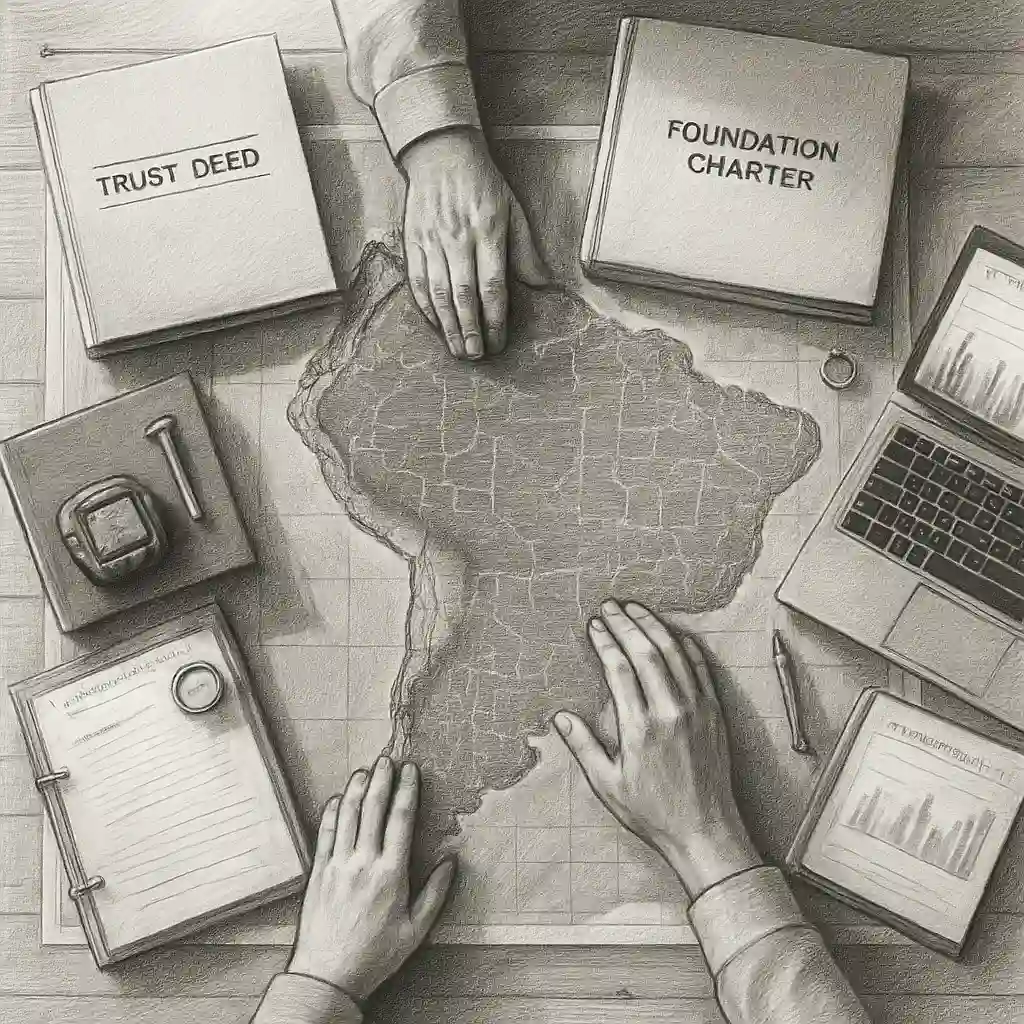Legacy Land - Structuring Amazon Land Holdings for Next-Gen Heirs

Owning primary rainforest is a gift—and a responsibility. If the structure lives only in the founder’s head, heirs inherit risk, not resilience.
This guide shows how structuring Amazon land holdings with trusts or foundations, clear governance and smart handover scenarios protects
people, nature and value.
General information only; get local legal advice before acting.
Nature-Backed Investments
Ultra-high-net-worth individuals are shifting from traditional vineyard investments to rainforest and nature-backed assets.
Explore Investment TrendsAyahuasca Safety Alerts
Critical government warnings and industry crisis updates regarding ayahuasca tourism and safety concerns in 2025.
Read Safety UpdatesWhat “structuring Amazon land holdings” really means
Think of your estate as three layers that must fit together:
-
Asset layer: titled land, concessions, easements, conservation areas, infrastructure.
-
Operating layer: a local company (OpCo) that holds permits, staff, equipment and contracts.
-
Succession layer: a trust or foundation that owns the parent company and defines purpose, payouts and continuity.
When these layers are separated, heirs can change an operator without touching the land mission, and governance survives founder turnover.
Why plan now, not later
-
Faster handover: probate delays across borders vanish when ownership is pre-arranged.
-
Lower friction: banks, buyers and partners prefer clean cap tables and defined voting rights.
-
Purpose lock: forest cover thresholds, community agreements and compliance duties outlive any one person.
-
Market access: documentation is “audit-ready” for exports and environmental reviews.
Best legal wrappers: trusts, foundations and a local holdco
Trust + Holdco (most common). Title and
permits sit in a local OpCo. A parent holdco owns the OpCo. A trust (or civil-law
foundation) owns the parent shares. The deed sets mission, beneficiary rules,
payouts and dispute paths.
Family foundation (civil-law). Works
like a perpetual owner with a council and a protector who can veto mission breaches.
Dual-entity split. LandCo holds title
and conservation covenants; OpCo runs eco-tourism, agroforestry or NTFP harvest.
The trust owns both and hard-codes stewardship rules.
Simple rule: put operations where the permits live; put succession where governance is strongest; keep purpose above both.
Step-by-step governance that survives you
1) Write a one-page mission
Example: “Protect 8,000 ha of lowland rainforest, create dignified local jobs and deliver cash yields above WACC without breaching forest cover thresholds.”
2) Build a mixed board
Two family seats, two independent experts (forestry/compliance), one community liaison as observer. Define quorum, conflict-of-interest and replacement rules.
3) Hard guardrails
-
No sales below independently appraised reserve price.
-
Zero encroachment in mapped HCV/HCS zones.
-
Environmental registry kept current (e.g., national rural cadaster where applicable).
-
Community MOUs honored and logged.
4) Dividend and reinvestment math
Pre-set a payout ratio and ring-fence budget for restoration, monitoring and compliance. This keeps the forest improving while cash flows remain predictable.
5) Paperwork that travels
Centralize titles, geo-maps (GPS/GeoJSON), permits, cadaster proofs, concession terms, tax IDs, staff files, management contracts and export due-diligence packs.
Country nuances to plan for (high-level, not legal advice)
-
Brazil: foreign control over rural land faces size and location limits; rural cadaster registration is mandatory. A local OpCo + trust/foundation upstream is typical.
-
Peru: foreigners cannot own land within 50 km of borders; trusts (fideicomisos) are administered by licensed fiduciaries; nearby community lands have strong protections.
-
Ecuador: foreigners generally enjoy the same property rights as nationals; still perform rigorous title and environmental due diligence.
Expat Destinations Guide
Comprehensive analysis of the best South American countries and cities for expats in 2025, including Peru's top locations.
Explore Best CitiesPeru Visa & Business Setup
Complete guide to obtaining various types of visas and registering companies in Peru with step-by-step procedures.
Learn Visa ProcessHandover scenarios (choose and adapt)
Scenario A — Two heirs, one operator
Trust owns the parent. Both heirs share economics; only the heir working in the business holds day-to-day authority, under board guardrails and KPI reporting.
Scenario B — Global family, local team
Foundation owns the group. Local OpCo runs forestry/ecotourism under a management contract. Independent chair approves an annual impact and compliance report before distributions.
Scenario C — Conservation-led estate
Conservation easements recorded over sensitive hectares. Commercial use sits in a separate OpCo. The deed mandates permanent forest cover at or above baseline and a fixed share of revenue for community projects.
Tips that keep heirs aligned
-
Draft a family constitution (five pages max).
-
Hold a quarterly Forest Day on site; big decisions are better on the ground.
-
Use a sale protocol: independent valuation and right of first offer.
-
Show plain-English dashboards: canopy loss, cadaster status, cash and community KPIs.
5 mistakes to avoid
-
Titling land in a personal name and triggering multi-country probate.
-
Ignoring foreign-ownership or border-zone limits when buying or transferring.
-
Keeping all passwords and permits with one “hero” employee.
-
Skipping independent directors—family deadlocks stall permits and sales.
-
Treating compliance as a chore instead of your market passport.
Checklist: documents your heirs will thank you for
-
Title bundle, surveys, easements, concessions, liens.
-
Corporate set: articles, shareholder register, minutes, powers of attorney.
-
Environmental: cadaster records, monitoring files, maps and buffers.
-
Community: MOUs, benefit-sharing, meeting notes and grievance log.
-
Operations: permits, management contracts, insurance, safety plans.
-
Trade: geolocation and due-diligence records for any exports.
-
Access: credential escrow with the trustee or protector.
Structuring Amazon land holdings means mission first, operations on the ground, succession above both. A trust or foundation, an experienced local operator and independent oversight turn hectares into a durable legacy your heirs can run with confidence.
FAQ
How can I pass Amazon land to heirs without probate?
Hold title through a local company, and place the parent company shares into a trust or foundation with clear beneficiary and voting rules.
What’s better in a civil-law context: trust or foundation?
Both can work. Trusts are contract-driven via a fiduciary; foundations act like a perpetual owner with a charter and council. Choose based on local availability and advisor depth.
How do we balance dividends and conservation?
Use a fixed payout ratio plus a ring-fenced regeneration and compliance budget. Review annually, but don’t touch the guardrails.
Can we keep operations flexible for the next generation?
Yes. Lock purpose and no-go zones, but let the board switch managers or operating contracts when performance or markets change.
What if our parcels neighbor community lands?
Create formal MOUs for access, benefit-sharing and conflict resolution. Add a community liaison as a board observer.
Do we need cadaster or environmental registration?
If your country requires a rural cadaster, register and keep it current. Store proofs in the data room so successors can pass audits quickly.
How do we avoid family deadlock?
Add two independent directors and a chair with tie-break powers. Define buy-sell mechanics and valuation rules in advance.
Can the structure evolve as heirs mature?
Build five-year review windows. You can update KPIs and contracts without changing mission clauses.
Ayahuasca Industry Crisis 2025
Critical analysis of the Ayahuasca tourism industry crisis. Government warnings, safety concerns, and regulatory changes affecting the sector in 2025.
Source: Industry Alert Report
Ayahuasca: Big Business Amazon
Investigation into the commercialization of Ayahuasca tourism. How traditional medicine became a multi-million dollar industry in the Amazon.
Source: Market Research Report
